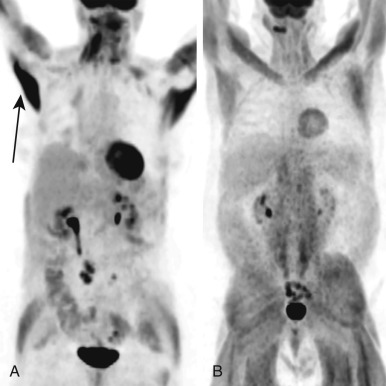Physical Address
304 North Cardinal St.
Dorchester Center, MA 02124
Positron emission tomography (PET) has become an important imaging tool in thoracic oncology over the past 10 to 20 years. It has proven its usefulness in the diagnosis of malignancies, initial staging, assessing response to treatment, and posttreatment monitoring for recurrence. Integration of PET with computed tomography (CT) initially and magnetic resonance (MR) lately has further improved its diagnostic accuracy, which has made it an invaluable factor in clinical decision making at tumor boards and interdisciplinary rounds. Although thoracic PET-CT and PET/MR have mainly been used for staging of non–small cell lung cancer (NSCLC) and lymphoma, their use has increasingly been broadened to many nononcologic conditions in the thorax as well, such as infectious and inflammatory processes.
PET imaging is based on a radionuclide whose decay produces positrons, which themselves emit 511-MeV photons when they encounter electrons. These emitted photons are subsequently captured by detectors in the PET machine. The most commonly used radionuclide in PET imaging is 18 F because of its most convenient half-life (110 minutes). Uptake of a radionuclide by the body is usually achieved by coupling of 18 F with a biologically active molecule, most commonly glucose. A newly formed 2-deoxy-2-fluoro-D-glucose ( 18 F-FDG) is transported into cells with membrane transporters and becomes intracellularly trapped after it is phosphorylated. Consequential accumulation of 18 F-FDG in these cells is detected on PET images. This mechanism of 18 F-FDG metabolism is particularly of benefit in oncology because malignant cancer cells have greater energy requirements than adjacent normal tissue and almost uniquely use glucose as their energy source. The degree of 18 F-FDG uptake in one specific region may be visually assessed or quantified with the standardized uptake value (SUV). SUV is a ratio between the amount of uptake in a tissue per unit of volume and a normalizing factor. An SUV of 2.5 is usually considered as a differentiating value between a pathologic process and normal uptake, but there can be significant overlap between benign and malignant lesions. It is more practical to subjectively assess the 18 F-FDG uptake in thoracic lesions by comparing it with the mediastinal blood pool. The lesion uptake is considered negative if 18 F-FDG uptake is less than mediastinal blood and equivocal if equal to the mediastinum. If the 18 F-FDG uptake in the lesion is greater than the mediastinum, it is considered positive.
Given the fact that 18 F-FDG molecule competes with glucose for transporters across the cell membrane, special preparation is required before PET imaging to decrease the blood glucose levels. Patients are usually instructed to refrain from vigorous physical activity and to follow a low-carbohydrate diet for 24 hours before the test. Furthermore, patients are asked not to eat or drink (except water) for 6 hours before a PET scan. Patients with diabetes are additionally instructed not to take insulin in the morning on the day of the examination; target morning glucose in these patients is between 80 and 180 mg/dL ( Fig. 4.1 ). PET scans performed for assessment of sarcoidosis may require prolonged pretest preparation with a high-fat, low-sugar diet (24–72 hours) and a longer fasting period (12 hours). This prolonged preparation also improves assessment of the myocardium.

Become a Clinical Tree membership for Full access and enjoy Unlimited articles
If you are a member. Log in here